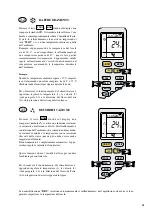
·
Connect the conditioner to a suitable electric line, which should be protected by a thermal-magnetic safety
switch suited to the electrical input of the appliance.
·
Never use the plug to stop the unit.
·
It is sometimes possible during operation to hear a noise similar to running water; this effect is caused by the
refrigerant flowing in the pipes and is quite normal.
·
When the conditioner starts or stops, particularly in heating, it is possible to hear some creakings caused by the
thermsl expansion of the unit parts.
WARNINGS AND IMPORTANT SAFETY INFORMATION
Never carry out maintenance which involves opening the machine: it could be dangerous due to the
presence of live parts and the gas contained in the refrigerating circuit. Always contact a specialized
Technical Service.
4
MAINTENANCE
CLEANING THE CONDITIONER
Remove the front panel of the unit (fig. 1) lifting it till its greatest stroke and then unhooking it from the hinges to
make the cleaning easier.
Clean the indoor unit using a cloth with lukewarm water (not higher than 40°C) and neutral soap. Never use
aggressive solvents or detergents.
If the battery of the outdoor unit is clogged, remove the leaves and the waste and then remove the dust with air
jet or a bit of water.
5
5.1
Before starting any cleaning disconnect the machine.
CLEANING OF THE FILTERS FOR WALL AIR CONDITIONER MODELS
The cleaning of the filters is essential for a good efficiency
of the conditioner.
ANTIDUST FILTERS
Open the front panel operating on the sides of the front grill in
the points indicated by the arrows (Fig. 1) and pull toward you.
Remove the filters by delicately extracting them downward (Fig.
2).
If the antidust filter is very dirty, it should be cleaned with a
vacuum cleaner or even washed with lukewarm water and neu-
tral soap.
Before inserting the filter again, it should be completely dry. It is
better to dry it in a ventilated place, but far from warmth sources
and direct sun exposition.
Never start the conditioner without filters.
ACTIVATED CARBON FILTERS (Optional)
The activated carbon filters, situated beneath the air filters (see
Fig. 3), absorb odours and smoke from the room and should be
changed regularly.
Fig. 1
Fig. 2
Antidust filter
Fig. 3
5.2
12










































